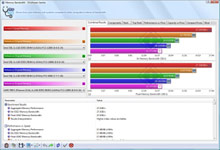SiSoft Sandra
Download from: www.sisoftware.netSiSoft Sandra is possibly the most famous benchmarking tool and, like Lavalys Everest, has tools to gauge the theoretical performance of every sub-system and component in your PC. Sandra is multi-threaded and we use it to gauge the unbuffered memory performance and the latency of the memory latency.
To run the unbuffered memory test, open the Benchmarks screen, go into the Options and deselect buffering. This will give a more accurate and consistent reading of memory throughput. Then enter the Graphs menu and deselect Animate Controls and Animate Tools - these options are designed for exhibitions like Computex or CES, and are just annoying for end users.
Hit F5 to run the benchmark and once it's finished enter the Graph menu and keep pressing Change Controls Mode until the graphs look like those below. You can now average the Internal Memory Bandwidth and Float Memory Bandwidth numbers to give the unbuffered memory performance.
The latency test is much easier to run - find the Memory Latency tool on the Benchmarks page and just run it by hitting F5. The latency is the top result in the text window.
The results in the SiSoft Sandra memory bandwidth test can be pretty neatly divided up into four groups – the Pentium E5200 with its slow FSB and DDR2, the Athlon X2s with slightly faster DDR2 then the new Athlon II X2 250 and the overclocked CPUs.
As expected, the latency of DDR3 is more than that of DDR2 at the same frequency - this is why the Phenom X2 7850 BE is 12ns faster than the Athlon II X2 250 at the same frequency, although overclocked the Athlon II is receives a substantial benefit from the higher bandwidth DDR3.

MSI MPG Velox 100R Chassis Review
October 14 2021 | 15:04











Want to comment? Please log in.